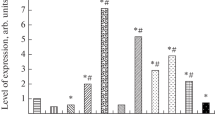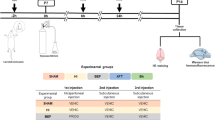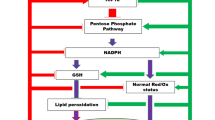Summary
-
1.
The protective effect of prostaglandins (PGs) against cerebral hypoxia/anoxia was investigated with a variety of experimental models in relation to their CNS depressant effects in mice. Furthermore, the effect of PGs on the changes of cerebral energy metabolites and cyclic nucleotide was examined in hypoxic mice. Mice were given s.c. doses of PGs 30 min before tests. Among the PGs tested, treatment with PGD2, PGE1 and PGI2 Na showed a consistent and dose-dependent protection against cerebral anoxia induced by all models studied: histotoxic anoxia by KCN, hypobaric hypoxia, normobaric hypoxia and decapitation-induced gasping. However, PGA1, PGA2, PGB1, PGB2, PGE2, PGF1α, PGF2α and 6-keto-PGF1α at a dose of 3mg/kg were without effect against normobaric hypoxia and gasping duration.
-
2.
The three PGs, i.e. PGD2, PGE1 and PGI2 which showed anti-hypoxic effects decreased locomotor activity and potentiated hexobarbital-induced sleep. On the other hand, PGE2, PGA1, PGA2 and PGB2 also caused a decrease in locomotor activity. Similarly, PGE2 and PGA1 caused a potentiation of hexobarbital-induced sleep, but interestingly they did not cause clear-cut increase in cerebral resistance to hypoxia, in contrast with the former three PGs. Thus general depression of CNS function appears not to be responsible for the PGD2-, PGE1- and PGI2-induced increase in cerebral resistance to hypoxia.
-
3.
The levels of Cr-P and ATP were significantly reduced and those of ADP and AMP were markedly elevated in hypoxic brain, resulting in a decrease in a calculated energy charge potential. The lactate level and lactate/pyruvate ratio increased and the glucose level decreased markedly. Also, an elevation in cyclic AMP was observed in hypoxic brain. Treatment with 1–3 mg/kg, s.c. of PGD2 or PGE1 and 0.1–3 mg/kg, s.c. of PGI2 Na was found to be effective against the changes of energy metabolites and cyclic nucleotide in hypoxic brain.
-
4.
Thus, PGD2, PGE1 and PGI2 possess a protective effect against cerebral hypoxia/anoxia by various causing, and it was suggested that these protective effect was related to an increase in the energy reserve available or a decrease in the cerebral energy demand.
Similar content being viewed by others
References
Atkinson DE (1968). The energy charge of the adenylate pool as a regulatory parameter: interaction with feedback modifiers. Biochemistry 7:4030–4034
Baźan NG Jr (1970) Effects of ischemia and electroconvulsive shock on free fatty acid pool in the brain. Biochim Biophys Acta 218:1–10
Bhattacharya SK, Mukhopadhyay SN, Debnath PK, Sanyal AK (1976) Role fo 5-hydroxytryptamine in prostaglandin E1 induced potentiation of hexobarbital hypnosis in albino rats. Experientia 32:907–908
Bosisio E, Galli C, Galli G, Nicosia S, Spagnuolo C, Tosi L (1976) Correlation between release of free arachidonic acid and prostaglandin formation in brain cortex and cerebellum. Protaglandins 11:773–781
Bradley PB, Samuels GMR, Shaw JE (1969) Correlations of prostaglandin release from the cerebral cortex of cats with electrocorticogram, following stimulation of the reticular formation. Br J Pharmac 37:151–159
Bradley PB, Samuels GMR (1971) The effect of drugs on the release of prostaglandins from the cerebral cortex. J Pharmac 2:51–52
Christie-Pope BC, Palmer GC, Poulakos L, Medina MA, Callahan AS, Palmer SJ (1984) Regional cyclic AMP system during secondary ischemia in gerbils: Influence of anesthetic agents. Exp Neurol 84:494–511
Duncan DB (1955) Multiple range and multiple F test. Biometrics (March) 1–42
Domschky K, Nelson M, Dammhayan B, Terjung E (1977) Flunarizine bei Patienten mit zerebraler und peripherer Mangeldurchblutung. Med Welt 28:1062–1064
Dorbin EI, Bloss JL, Potts WJ (1973) Neuropharmacological and behavioral toxicity studies with prostaglandin A2. Toxicol Appl Pharmacol 25:460–461
Ellis EF, Wei EP, Kontos HA (1979) Vasoddation of cat cerebral arterioles by prostaglandin D2, E2, G2, and I2. Am J Physiol 237:H381-H385
Folco GC, Longiave D, Bosisio E (1977) Relations between prostaglandin E2, F2α and cyclic nucleotides levels in rat brain and induction of convulsions. Prostaglandins 13:893–900
Förstermann U, Heldt R, Knappen F, Hertting G (1982) Potential anticonvulsive properties of endogenous prostaglandins formed in mouse brain. Brain Res 240:303–310
Förstermann U, Heldt R, Hertting G (1983) Effects of intracerebroventricular administration of protaglandin D2 on behaviour, blood pressure and body temperature as compared to prostaglandins E2 and F2α. Psychopharmacology 80:365–370
Gaudet RJ, Alam I, Levine L (1980) Accumulation of cyclo-oxygenase products of arachidonic acid metabolism in gerbil brain during reperfusion after bilateral common carotid artery occulusion. Neurochemistry 35:653–658
Gilmore DP, Shaikh AA (1972) The effect of prostaglandin E2 in inducing sedation in the rat. Prostaglandins 2:143–151
Gross RA, Ferrendelli JA (1980) Mechanisms of cyclic AMP regulation in cerebral anoxia and their relationship to glycogenolysis. J Neurochem 34:1309–1318
Haubrich DR, Perz-Cruet J, Reid WD (1973) Prostaglandin E1 causes sedation and increases 5-hydroxytryptamine turnover in rat brain. Br J Pharmac 48:80–87
Holmes SW, Horton EW (1968) Prostaglandins and the central nervous system. In: Ramwell PW, Shaw JE (eds) Prostaglandin Symposium of the Worcester Foundation for Experimental Biology, Interscience, New York, pp 21–38
Horton EW (1964) Actions of prostaglandins E1, E2, and E3 on the central nervous system. Brit J Pharmac 22: 189–194
Kuwashima J, Fujitani B, Nakamura K, Kadokawa T, Yoshida K, Shimizu M (1976) Biochemical changes in unilateral brain injury in the rat: a possible role of free fatty acid accumulation. Brain Res 110:547–557
Laychock SG, Johnson DN, Harris LS (1980) PGD2 effects on rodent behavior and EEG pattern in cats. Pharmacol Biochem Behav 12:747–754
Lefer AM, Ogletree ML, Smith JB, Silver MJ, Nicolaou KC, Barnette WE, Gasic GP (1978) Prostacyclin: A potentially valuable agent for preserving myocardial tissue in acute myocardial ischemia. Science 200:52–54
Lefer AM, Tabas J, Smith EF (1980) Salutary effects of prostacyclin in endotoxic shock. Pharmacology 21:206–212
Lowry OH, Passoneau JV, Hosselberger FX, Schulz DW (1964) Effect of ischemia on known substrates and factors of the glycolytic pathway in brain. J Biol Chem 239:18–30
Lust WD, Mrsulja BB, Mrsulja BJ, Passonneau JV, Klanzo I (1975) Putative neurotransmitters and cyclic nucleotides in prolonged ischemia of the cerebral cortex. Brain Res 98:394–399
Masuda Y, Shiraishi Y, Ochi Y, Karasawa T, Shimizu M (1984) Protective effect of prostaglandin D2, E1, and I2 against cerebral anoxia in mice. Japan J Pharmacol 36 (Suppl):330 P
Masuda Y, Ochi Y, Karasawa T, Hatano N, Kadokawa T, Okegawa T (1986) Protective effect of a new prostacyclin analogue OP-2507 against cerebral anoxia and edema in experimental animals. Eur J Pharmacol 123:335–344
Nikolov R, Nikolova M, Miyares C, Milanova D, (1982) Antihypoxic effect of prostacyclin. Meth Find Exptl Clin Pharmacol 4:211–219
Palmer GC (1985) Cyclic nucleotides in stroke and related cerebrovascular disorders. Life Sci 36:1995–2006
Poddubiuk ZM (1976) A comparison of central actions of prostaglandins A1, E1, E2, F1α, and F2α in the rat. Psychopharmacology 50:89–94
Potts WJ, East PF (1971) The effect of prostaglandin E2 on conditioned avoidance response performance in rats. Arch Int Pharmacodyn 191:74–79
Ramwell PW, Shaw JW (1966) Spontaneous and evoked release of prostaglandins from the cerebral cortex of anesthetized cats. Am J Physiol 211:125–134
Raviprakash V, Sabir M (1978) Effect of various prostaglandins on hexobarbital-induced sleep in mice. Indian J Med 67:321–324
Rösen R, Rösen P, Ohlendorf R, Schrör K (1981) Prostacyclin prevents ischemia-induced increase of lactate and cyclic AMP in ischemic myocardium. Eur J Pharmacol 69:489–491
Rosenkranz RP, Killam KF Jr (1978) Effects of prostacyclin and 6-keto PGF1α on electrically induced convulsions in mice. Life Sci 23:2609–2616
Rosner I, Legros J, Berger C (1971) Protective activity of some antianginal drugs on asphyxic anoxia of the brain: a contribution to their laboratory evaluation. Arch. Int Pharmacodyn 194:375–380
Schwartz JP, Mrsulja BB, Mrsulja BJ, Passonneau JV, Klatzo I (1976) Alterations of cyclic nucleotide-related enzymes and ATPase during unilateral ischemia and recirculation in gerbil cerebral cortex. J Neurochem 27:101–107
Schrör K, Addicks K, Darius H, Ohlendorf R, Rösen P (1981) PGI2 inhibits ischemia-induced platelet activation and prevents myocardial damage by inhibition of catecholamine release from adrenergic nerve terminales. Evidence for cAMP as common denominator. Thrombosis Res 21:175–180
Simojo S, Scheinberg P, Kogure K, Reinmuth OM (1968) The effects of graded hypoxia upon transient cerebral blood flow oxygen consumption. J Neurosurg 18:127–133
Steinhauer HB, Anhut H, Hertting G (1979) The synthesis of prostaglandins and thromboxane in the mouse brain in vivo. Influence of drug induced convulsions, hypoxia and the anticonvulsants trimethadione and diazepam. Naunyn-Schmiedebergs' Arch Pharmacol 310:53–58
Taylor MD, Palmer GC, Callahan AS (1982) Alterations of catecholamine-sensitive adenylate cyclase in gerbil cerebral cortex after bilateral ischemia. Exp Neurol 76:495–507
Toyoda M, Takagi S, Seki T, Takeoka T, Gotoh F (1975) Effect of a new vasodialtor (flunarizine) on the cerebral circulation. J Neurol Sci 25:371–375
Welch KM, Knowles L (1974) Local effects on prostaglandins on cat pial arteries. Eur J Pharmacol 24:155–158
Wolfe LS, Coceani F (1979) The role of prostaglandins in the central nervous system. Ann Rev Physiol 41:669–684
Author information
Authors and Affiliations
Rights and permissions
About this article
Cite this article
Masuda, Y., Ochi, Y., Ochi, Y. et al. Protective effect of prostaglandins D2, E1 and I2 against cerebral hypoxia/anoxia in mice. Naunyn-Schmiedeberg's Arch. Pharmacol. 334, 282–289 (1986). https://doi.org/10.1007/BF00508783
Received:
Accepted:
Issue Date:
DOI: https://doi.org/10.1007/BF00508783




